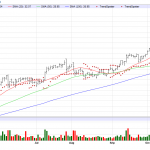Almost one year ago, in March 2015, we explained how “The Fed’s Artificial Steepening Of The Yield Curve” has resulted in many unexpected consequences, the most important of which has been the erroneous interpretation of the yield curve as a leading recessionary signal. As said back then, “the artificially steep yield curve is a reflection of policy intent not economic reality…. Where the yield curve in the all-important belly of the 5s10s might have deeply inverted in the past just prior to recession, there is no justification to expect the same attainment of absolute levels where artificial monetary intrusion has pushed the curve much, much steeper.”
One week ago, it was as if a light bulb went off over Wall Street’s head, when first Deutsche Bank’s Dominic Konstam realized the significance of the above excerpt, and admitted that far from the 4% recession odds that the Fed’s hopeless FRB/US DSGE computer model spews out when looking at the “normal” yield curve, when normalizing for the Fed’s intervention odds of a recession in the next 12 months soar to 50%.
In a special report published earlier this week, we noted that today’s near-zero interest rate regime does not allow the yield curve to freely invert or even flatten too much because of certain structural limits. For example, liabilities-driven investors who in the past could receive long rates below the fed funds rate can no longer do so once rates are floored at zero. Investment fund managers are also restricted by mandates from buying negative yielding assets that lead to mark-to-market losses on their portfolios. Pension investors, who must target returns based on liability assumptions, have been driven into high yielding non-core rate assets as their discount rates are stubbornly and unrealistically high compared to Treasury yields. These factors keep the curve artificially steep even though both short and long rates have been clearly trending downward over the years.
An “artificially steep yield curve” – almost as if that’s exactly the phrase we used before. What DB did then is the logical next step: to adjust the artificial yield curve and exclude the Fed’s intervention.
To address the artificial steepness of the curve we corrected the 3m10y spread for the level of the rates. Specifically we regressed the spread against the short rate, leaving the residual which by definition removes for the bias of the rate level and is centered at zero. Using this new curve as model input, we found the probability of a recession in the next 12 months is 46 percent, considerably higher than the original Fed model has predicted.
But wait, there’s more, because while the short-end remains anchored, with every 25 bps tightening in the 10Y yield, recession odds rise by another 6%.
At Friday’s close, recession odds are well over 50% according to DB’s model.
Or perhaps far higher, because shortly after DB admitted what we said in early 2015, namely that everyone who was looking at the yield curve as is was wrong, Bank of America’s Ruslan Bikbov did the exact same analysis and ended up with a far more disturbing conclusion:
The US Treasury curve is still steep by historical standards. Taken at face value, this may suggest recession odds are small. However, we argue this logic is flawed because the curve is structurally steep when the Fed Funds rate is close to zero. When adjusted for the proximity of rates to zero, the curve may already be inverted and therefore may already be priced for a recession.











Leave A Comment